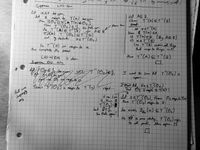Difference between revisions of "Continuous map"
m (→Continuous at a point) |
m (→Sequentially continuous at a point) |
||
| Line 49: | Line 49: | ||
Claim: {{M|f}} is continuous at {{M|x_0}} using the neighbourhood definition {{M|\iff}} it is continuous at {{M|x_0}} using the sequential definition | Claim: {{M|f}} is continuous at {{M|x_0}} using the neighbourhood definition {{M|\iff}} it is continuous at {{M|x_0}} using the sequential definition | ||
{{Begin Proof}} | {{Begin Proof}} | ||
| − | {{Todo| | + | '''Proof: ''' neighbourhood {{M|\implies}} sequential: |
| + | : Let {{M|1=(x_n)_{n=1}^\infty}} be given, and that {{M|(x_n)\rightarrow x}} - we wish to show that {{M|1=\lim_{n\rightarrow\infty}(f(x_n))=f(x)}} | ||
| + | :: Let {{M|\epsilon > 0}} be given. | ||
| + | ::: By hypothesis, as {{M|B_\epsilon(f(x))}} is a neighbourhood of {{M|f(x)}} then {{M|f^{-1}(B_\epsilon(f(x)))}} is a neighbourhood to {{M|x}} | ||
| + | :::: So {{M|\exists\delta>0[B_\delta(x)\subseteq f^{-1}(B_\epsilon(f(x)))}} | ||
| + | ::::* By the [[implies-subset relation]] if {{M|B_\delta(x)\subseteq f^{-1}(B_\epsilon(f(x)))}} then {{M|a\in B_\delta(x)\implies a\in f^{-1}(B_\epsilon(f(x)))}} | ||
| + | ::: Choose {{M|N\in\mathbb{N} }} such that {{M|n>N\implies d_1(x_n,x)<\delta}} (which we can do because {{M|(x_n)\rightarrow x}}) | ||
| + | :::* Note that {{M|d_1(x_n,x)<\delta\implies x_n\in B_\delta(x)}} | ||
| + | ::: So {{M|x_n\in B_\delta(x)\implies x_n\in f^{-1}(B_\epsilon(f(x)))}} | ||
| + | :::* But if {{M|a\in f^{-1}(B)}} then {{M|f(a)\in B}} as {{M|f^{-1}(B)}} contains exactly the things which map to an element of {{M|B}} under {{M|f}} | ||
| + | ::: So {{M|f(x_n)\in B_\epsilon(f(x))}} | ||
| + | :: But {{M|f(x_n)\in B_\epsilon(f(x))\iff d_2(f(x_n),f(x))<\epsilon}} | ||
| + | : This completes the proof | ||
| + | :* we have shown that given an {{M|\epsilon > 0}} that there exists an {{M|N}} such that for {{M|n>N}} we have {{M|d_2(f(x_n),f(x))<\epsilon}} which is exactly the definition of {{M|(f(x_n))\rightarrow f(x)}} | ||
| + | |||
| + | '''Proof: ''' sequential {{M|\implies}} neighbourhood: | ||
| + | {{Todo|This - See Analysis I - Maurin page 44 if stuck}} | ||
| + | [[Category:First-year friendly]] | ||
{{End Proof}} | {{End Proof}} | ||
{{End Theorem}} | {{End Theorem}} | ||
| + | |||
==References== | ==References== | ||
<references/> | <references/> | ||
Revision as of 14:51, 24 November 2015
- Note: there are a few different conditions for continuity, there's also continuity at a point. This diagram is supposed to show how they relate to each other.
|
[math]\begin{xy}\xymatrix{ \text{Continuous} \ar@2{<->}[d]_-{\text{claim }1} \ar@2{<.>}[drr] & & \\ {\begin{array}{lr}\text{Continuous at }x_0\\ \text{(neighbourhood)}\end{array} } \ar@2{<->}[rr]_{\text{claim }2} & & {\begin{array}{lr}\text{Continuous at }x_0\\ \text{(sequential)}\end{array} } }\end{xy}[/math] |
Note that:
|
| Overview | Key |
|---|
Contents
Definition
Given two topological spaces [ilmath](X,\mathcal{J})[/ilmath] and [ilmath](Y,\mathcal{K})[/ilmath] we say that a map, [ilmath]f:X\rightarrow Y[/ilmath] is continuous if[1]:
- [ilmath]\forall\mathcal{O}\in\mathcal{K}[f^{-1}(\mathcal{O})\in\mathcal{J}][/ilmath]
That is to say:
- The pre-image of every set open in [ilmath]Y[/ilmath] under [ilmath]f[/ilmath] is open in [ilmath]X[/ilmath]
Continuous at a point
Again, given two topological spaces [ilmath](X,\mathcal{J})[/ilmath] and [ilmath](Y,\mathcal{K})[/ilmath], and a point [ilmath]x_0\in X[/ilmath], we say the map [ilmath]f:X\rightarrow Y[/ilmath] is continuous at [ilmath]x_0[/ilmath] if[1]:
- [ilmath]\forall N\subseteq Y[/ilmath][ilmath]\text{ neighbourhood to } [/ilmath][ilmath]T(x_0)[f^{-1}(N)\text{ is a neighbourhood of }x_0][/ilmath]
UNPROVED: I suspect that this is the same as [ilmath]\forall\mathcal{O}\in\mathcal{K}[f(x_0)\in\mathcal{O}\implies f^{-1}(\mathcal{O})\in\mathcal{J}\wedge x_0\in f^{-1}(\mathcal{O})][/ilmath] - this is basically the same just on open sets instead
TODO: Investigate and prove the highlighted claim
(Leave any notes to self here)
Claim 1
Claim: The mapping [ilmath]f[/ilmath] is continuous [ilmath]\iff[/ilmath] it is continuous at every point
Sequentially continuous at a point
Given two topological spaces [ilmath](X,\mathcal{J})[/ilmath] and [ilmath](Y,\mathcal{K})[/ilmath], and a point [ilmath]x_0\in X[/ilmath], a function [ilmath]f:X\rightarrow Y[/ilmath] is said to be continuous at [ilmath]x_0[/ilmath] if[1]:
- [math]\forall (x_n)_{n=1}^\infty\left[\lim_{n\rightarrow\infty}(x_n)=x\implies\lim_{n\rightarrow\infty}(f(x_n))=f(x)\right][/math] (Recall that [ilmath](x_n)_{n=1}^\infty[/ilmath] denotes a sequence, see Limit (sequence) for information on limits)
Claim 2
Claim: [ilmath]f[/ilmath] is continuous at [ilmath]x_0[/ilmath] using the neighbourhood definition [ilmath]\iff[/ilmath] it is continuous at [ilmath]x_0[/ilmath] using the sequential definition
Proof: neighbourhood [ilmath]\implies[/ilmath] sequential:
- Let [ilmath](x_n)_{n=1}^\infty[/ilmath] be given, and that [ilmath](x_n)\rightarrow x[/ilmath] - we wish to show that [ilmath]\lim_{n\rightarrow\infty}(f(x_n))=f(x)[/ilmath]
- Let [ilmath]\epsilon > 0[/ilmath] be given.
- By hypothesis, as [ilmath]B_\epsilon(f(x))[/ilmath] is a neighbourhood of [ilmath]f(x)[/ilmath] then [ilmath]f^{-1}(B_\epsilon(f(x)))[/ilmath] is a neighbourhood to [ilmath]x[/ilmath]
- So [ilmath]\exists\delta>0[B_\delta(x)\subseteq f^{-1}(B_\epsilon(f(x)))[/ilmath]
- By the implies-subset relation if [ilmath]B_\delta(x)\subseteq f^{-1}(B_\epsilon(f(x)))[/ilmath] then [ilmath]a\in B_\delta(x)\implies a\in f^{-1}(B_\epsilon(f(x)))[/ilmath]
- So [ilmath]\exists\delta>0[B_\delta(x)\subseteq f^{-1}(B_\epsilon(f(x)))[/ilmath]
- Choose [ilmath]N\in\mathbb{N} [/ilmath] such that [ilmath]n>N\implies d_1(x_n,x)<\delta[/ilmath] (which we can do because [ilmath](x_n)\rightarrow x[/ilmath])
- Note that [ilmath]d_1(x_n,x)<\delta\implies x_n\in B_\delta(x)[/ilmath]
- So [ilmath]x_n\in B_\delta(x)\implies x_n\in f^{-1}(B_\epsilon(f(x)))[/ilmath]
- But if [ilmath]a\in f^{-1}(B)[/ilmath] then [ilmath]f(a)\in B[/ilmath] as [ilmath]f^{-1}(B)[/ilmath] contains exactly the things which map to an element of [ilmath]B[/ilmath] under [ilmath]f[/ilmath]
- So [ilmath]f(x_n)\in B_\epsilon(f(x))[/ilmath]
- By hypothesis, as [ilmath]B_\epsilon(f(x))[/ilmath] is a neighbourhood of [ilmath]f(x)[/ilmath] then [ilmath]f^{-1}(B_\epsilon(f(x)))[/ilmath] is a neighbourhood to [ilmath]x[/ilmath]
- But [ilmath]f(x_n)\in B_\epsilon(f(x))\iff d_2(f(x_n),f(x))<\epsilon[/ilmath]
- Let [ilmath]\epsilon > 0[/ilmath] be given.
- This completes the proof
- we have shown that given an [ilmath]\epsilon > 0[/ilmath] that there exists an [ilmath]N[/ilmath] such that for [ilmath]n>N[/ilmath] we have [ilmath]d_2(f(x_n),f(x))<\epsilon[/ilmath] which is exactly the definition of [ilmath](f(x_n))\rightarrow f(x)[/ilmath]
Proof: sequential [ilmath]\implies[/ilmath] neighbourhood:
TODO: This - See Analysis I - Maurin page 44 if stuck
References
Old page
First form
The first form:
[math]f:A\rightarrow B[/math] is continuous at [math]a[/math] if:
[math]\forall\epsilon>0\exists\delta>0:|x-a|<\delta\implies|f(x)-f(a)|<\epsilon[/math] (note the implicit [math]\forall x\in A[/math])
Second form
Armed with the knowledge of what a metric space is (the notion of distance), you can extend this to the more general:
[math]f:(A,d)\rightarrow(B,d')[/math] is continuous at [math]a[/math] if:
[math]\forall\epsilon>0\exists\delta>0:d(x,a)<\delta\implies d'(f(x),f(a))<\epsilon[/math]
[math]\forall\epsilon>0\exists\delta>0:x\in B_\delta(a)\implies f(x)\in B_\epsilon(f(a))[/math]
In both cases the implicit [math]\forall x[/math] is present. Basic type inference (the [math]B_\epsilon(f(a))[/math] is a ball about [math]f(a)\in B[/math] thus it is a ball in [math]B[/math] using the metric [math]d'[/math])
Third form
The most general form, continuity between topologies
[math]f:(A,\mathcal{J})\rightarrow(B,\mathcal{K})[/math] is continuous if
[math]\forall U\in\mathcal{K}\ f^{-1}(U)\in\mathcal{J}[/math] - that is the pre-image of all open sets in [math](A,\mathcal{J})[/math] is open.
